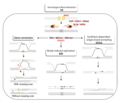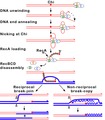Homologous recombination
Homologous recombination (HR) is a critical process in cellular DNA repair, genetic recombination, and the maintenance of genomic stability. It involves the exchange of genetic information between two similar or identical molecules of DNA. HR is essential for the repair of double-strand breaks (DSBs), the resolution of stalled replication forks, and the segregation of chromosomes during meiosis.
Mechanism[edit]
The process of homologous recombination begins with the sensing and processing of a DSB. The broken DNA ends are first resected to produce 3' single-stranded DNA (ssDNA) tails. This ssDNA is then coated by the recombinase protein RAD51, which displaces the replication protein A (RPA) and forms a nucleoprotein filament. This RAD51-ssDNA filament searches for and invades a homologous DNA duplex, forming a displacement loop (D-loop). The invading 3' end of the ssDNA then primes DNA synthesis, using the homologous strand as a template. Following DNA synthesis, the resulting joint molecules can be resolved through different pathways, leading to crossover or non-crossover outcomes.
Functions[edit]
Homologous recombination serves several vital functions in the cell:
- DNA Repair: HR is one of the main pathways for repairing DSBs, which can arise from external sources, such as ionizing radiation, or internal sources, such as replication fork collapse. By using a homologous sequence as a template for repair, HR ensures high-fidelity restoration of the original DNA sequence.
- Replication Fork Support: HR assists in the restart of stalled replication forks, a critical function for the prevention of genomic instability.
- Meiotic Recombination: During meiosis, HR facilitates the exchange of genetic material between homologous chromosomes, promoting genetic diversity in gametes.
Regulation[edit]
The regulation of homologous recombination is complex and involves numerous proteins and pathways. Key regulators include the BRCA1 and BRCA2 proteins, which play significant roles in the repair of DSBs through HR. Mutations in these genes are linked to a higher risk of breast and ovarian cancers, underscoring the importance of HR in preventing tumorigenesis.
Clinical Significance[edit]
Defects in homologous recombination can lead to genomic instability, a hallmark of cancer. Consequently, understanding HR mechanisms has implications for cancer biology and therapy. Inhibitors of proteins involved in HR, such as PARP inhibitors, have shown promise in treating cancers with HR deficiencies, exemplifying the therapeutic potential of targeting this pathway.
See Also[edit]
References[edit]
<references/>

This article is a molecular biology stub. You can help WikiMD by expanding it!
-
Homologous recombination
-
Homologous recombination
-
Homologous recombination
-
Homologous recombination
-
Homologous recombination
-
Homologous recombination
-
Homologous recombination
-
Homologous recombination
-
Homologous recombination
-
Homologous recombination
Ad. Transform your life with W8MD's Budget GLP-1 injections from $75


W8MD offers a medical weight loss program to lose weight in Philadelphia. Our physician-supervised medical weight loss provides:
- Weight loss injections in NYC (generic and brand names):
- Zepbound / Mounjaro, Wegovy / Ozempic, Saxenda
- Most insurances accepted or discounted self-pay rates. We will obtain insurance prior authorizations if needed.
- Generic GLP1 weight loss injections from $75 for the starting dose.
- Also offer prescription weight loss medications including Phentermine, Qsymia, Diethylpropion, Contrave etc.
NYC weight loss doctor appointmentsNYC weight loss doctor appointments
Start your NYC weight loss journey today at our NYC medical weight loss and Philadelphia medical weight loss clinics.
- Call 718-946-5500 to lose weight in NYC or for medical weight loss in Philadelphia 215-676-2334.
- Tags:NYC medical weight loss, Philadelphia lose weight Zepbound NYC, Budget GLP1 weight loss injections, Wegovy Philadelphia, Wegovy NYC, Philadelphia medical weight loss, Brookly weight loss and Wegovy NYC
|
WikiMD's Wellness Encyclopedia |
| Let Food Be Thy Medicine Medicine Thy Food - Hippocrates |
Medical Disclaimer: WikiMD is not a substitute for professional medical advice. The information on WikiMD is provided as an information resource only, may be incorrect, outdated or misleading, and is not to be used or relied on for any diagnostic or treatment purposes. Please consult your health care provider before making any healthcare decisions or for guidance about a specific medical condition. WikiMD expressly disclaims responsibility, and shall have no liability, for any damages, loss, injury, or liability whatsoever suffered as a result of your reliance on the information contained in this site. By visiting this site you agree to the foregoing terms and conditions, which may from time to time be changed or supplemented by WikiMD. If you do not agree to the foregoing terms and conditions, you should not enter or use this site. See full disclaimer.
Credits:Most images are courtesy of Wikimedia commons, and templates, categories Wikipedia, licensed under CC BY SA or similar.
Translate this page: - East Asian
中文,
日本,
한국어,
South Asian
हिन्दी,
தமிழ்,
తెలుగు,
Urdu,
ಕನ್ನಡ,
Southeast Asian
Indonesian,
Vietnamese,
Thai,
မြန်မာဘာသာ,
বাংলা
European
español,
Deutsch,
français,
Greek,
português do Brasil,
polski,
română,
русский,
Nederlands,
norsk,
svenska,
suomi,
Italian
Middle Eastern & African
عربى,
Turkish,
Persian,
Hebrew,
Afrikaans,
isiZulu,
Kiswahili,
Other
Bulgarian,
Hungarian,
Czech,
Swedish,
മലയാളം,
मराठी,
ਪੰਜਾਬੀ,
ગુજરાતી,
Portuguese,
Ukrainian











